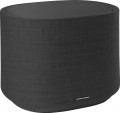Acoustic design
—
Closed type. The simplest type of construction: a closed (sometimes hermetically sealed) case with a speaker placed on the front panel. It is believed that such subwoofers have low sensitivity, which, however, is offset by high sound transmission accuracy and low distortion.
—
Phase inverter type. In the cases of such subwoofers, a tube is installed that has an outlet to the surrounding space. The length of the tube is chosen so that a signal comes out of it, inverted in phase relative to the signal from the front of the cone (in other words, from the main speaker). This improves the sound of the subwoofer and enhances the sound pressure. The disadvantage of a phase inverter is the additional noise from the sound stream in the tube.
—
With a passive radiator. A design similar to a phase inverter (see above) in terms of purpose and principle of operation, however, instead of a tube, such subwoofers use the so-called passive emitter. In fact, it is an ordinary speaker, devoid of a coil and a magnet and playing the same role as the phase inverter tube. The use of a passive radiator allows you to get rid of the noise of the air flow, characteristic of phase inverters.
Phase inverter location
—
Behind. It is recommended to install subwoofers with a rear bass reflex so that the back of the case, where the bass reflex is located, is away from the wall. If you put such a subwoofer right next to the wall, then the sound quality will be noticeably reduced. Bass reflex subwoofers on the back of the cabinet are usually placed in the centre of the room. If it is not possible to put acoustics in the centre, then they try to place this type of subwoofers away from the wall that the bass reflex is looking at.
—
Front. Front-facing bass reflex subwoofers are good if the acoustics need to deeply reveal the image of low-frequency sound. Acoustics of this type are recommended for music in which there is a lot of bass. The front location of the phase inverter allows you to put the subwoofer almost close to the wall.
—
From below. Bass reflex subwoofers are designed to be hung at a height. In this case, there will be no interference in the path of low-frequency sound, that is, the bass will be revealed as fully as possible. If it is not possible to hang such a subwoofer, then it is permissible to put the acoustics on a high stand. But the stand should not overlap the phase inverter.
—
Sideways. Subwoofers with a side bass reflex can be placed close to the wall and in the corner, but if the corner wall does
...not block the bass reflex. The lateral location of the phase inverter allows acoustics to focus on mid-frequency and high-frequency sound. The low frequency sound will become moderate. This is the optimal acoustic scheme for watching movies.Max. sound pressure level
The highest sound pressure level that a subwoofer can create, in other words, the volume that it produces at its maximum power level. This parameter is measured in the same way as any noise level - in decibels; since the decibel is a non-linear quantity, it is easiest to evaluate loudness using comparative tables. So, the most modest modern subwoofers are capable of delivering up to 95 – 100 dB, this is comparable to the volume of a subway car or a chainsaw. In the most powerful ones, it can exceed 130 dB - this is louder than an airplane on takeoff, a long stay near a subwoofer operating at full power can lead to hearing damage.
Note that sound pressure and sensitivity (see above) are fundamentally different characteristics, although they are measured by the same units.
Frequency range
The range of audio frequencies reproduced by the subwoofer. As a general rule, the wider the frequency range, the richer the sound and the more detail the speaker can convey. However, it is worth remembering that subwoofers as a class are designed for low and ultra-low frequencies in the range from 20 to 150 (sometimes 200) Hz. Therefore, in fact, a significant difference in sound is noticeable only with a large difference in the reproducible ranges (for example, 20-200 Hz and 50-150 Hz).
Also, do not forget that an extensive frequency range is not yet a guarantee of high-quality sound; and in some cases (for example, if the main speakers of the speaker also cope well with low frequencies), it may be completely redundant.
Remote control
A device that allows you to control the functions of the subwoofer from a distance — literally from the comfort of your sofa. Note that, unlike other consumer electronics,
the subwoofer remote control can be wired.

